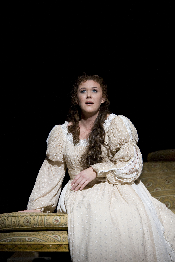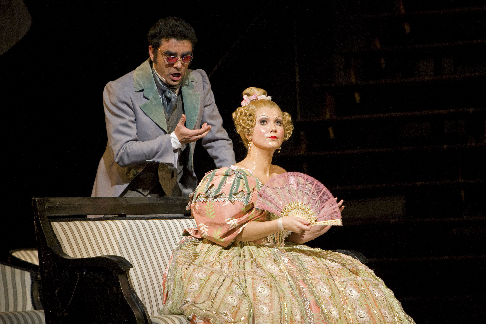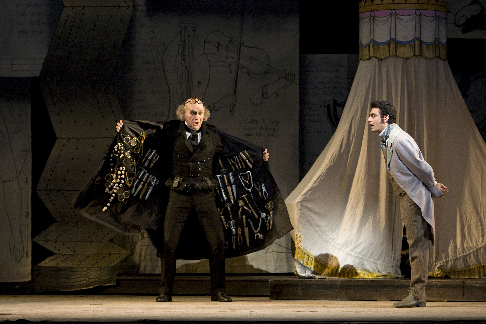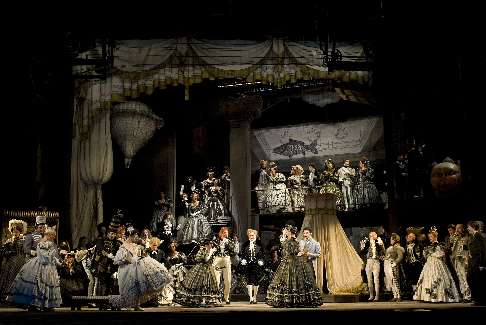28 Nov 2008
The Tales of Hoffmann at Covent Garden
The opening performance of the ROH’s seventh revival of John Schlesinger’s 1980 production of The Tales of Hoffmann was dedicated to the memory of Richard Hickox.

The opening performance of the ROH’s seventh revival of John Schlesinger’s 1980 production of The Tales of Hoffmann was dedicated to the memory of Richard Hickox.
Hickox, who died suddenly on Sunday, had conducted the 2004 revival of this opera, the production in which Rolando Villazón created a sensation in the title role and instantly became a household name.
Returning to the role, one which is a gift to such a versatile and committed character player, Villazón seemed older and wiser: more mature in his interpretation, instantly establishing his presence with the inebriate bluster of the Prologue’s Kleinzach song but equally comfortable with the nostalgic reveries of the Epilogue; and more astute in his pacing, somewhat restrained at the start but sensibly conserving his voice, relaxing and releasing a tone of warmth and ardour in the final scenes.
 Katie Van Kooten as Antonia
Katie Van Kooten as Antonia
The production itself cannot be said to have made the same graceful
passage to maturity. The revival director, Christopher Cowell, has retained
the original Personenregie, with scarcely a fresh gesture. And, the
old sets looked tired and fussy, even tawdrily camp: sumptuously extravagant
and evocative of the opera’s various locations they may be, but the
accumulation of superfluous detail results in a rather dated literalism
— the ‘real’ gondola, the giant ‘floating’ bed
and miles of vermillion velvet hammer home their points but leave little room
for subtlety or imaginative nuance. Hoffmann’s original short stories
combine artistry and grotesquery, sparkling glitter and dark, ponderous
depths; yet this production seldom scratches beneath the surface, frequently
lapsing into gratuitous, pantomimic clichés.
This was a solid rather than a stunning cast. Of the female roles, Ekaterina Lekhina as Olympia was the audience favourite although this listener found her rather underwhelming; but she was jerkily, jitteringly suggestive of a soulless automaton, and certainly conquered the vocal peaks with confidence and accuracy of intonation, although there was little sense of continuity of line as she scaled the precipices. Katie van Kooten was an impressive Antonia, her radiant upper range strong and clear, although underneath the intonation was sometimes suspect and marred by unfocused note production. Christine Rice’s Guilietta was an intelligent, dramatically convincing performance, the powerful lower register of her resonant dark mezzo delightfully sensuous, perfectly conveying the courtesan’s allure. However, at times she overpowered Villazón in their duet textures, for while his high-lying lines were delivered with cleanness and panache, he was more subdued in the lower registers. Moreover, the erotic intertwining of the intended soprano and mezzo timbres in Guilietta’s duet with Niklausse, another mezzo, were diminished. Indeed, despite Rice’s intelligent portrayal, the Venetian act was the least successful; the assorted writhing couples languorously scattered about the opulent milieu evoked little genuine sensuality, and the whole lacked dramatic tension.
In the dual role of Niklausse/Muse, Kristine Jepson’s bright, animated tone projected well. Jepson has much stage confidence and natural ease; and she established an engaging relationship with Villazón which would have benefited from more sensitive and encouraging direction.
 Rolando Villazón as Hoffmann and Ekaterina Lekhina as Olympia
Rolando Villazón as Hoffmann and Ekaterina Lekhina as Olympia
Gidon Saks was a pantomime villain and rather underpowered nemesis. While his Act 2 Dr Miracle oozed menace and malevolence, both characterisation and projection weakened in the later stages of the opera. The veteran character tenor, Graham Clark, had tremendous fun in his multiple roles as the four servants, raising many a laugh; but his grotesque shrieks and exaggerated affectations destroyed the poignancy of Hoffmann’s demise.
The minor roles were uniformly compelling: Matthew Rose was Crespel, Robin Leggate, Spalanzani, and Gaynor Keeble, the spirit of Stella’s mother. Kostas Smoriginas was a commanding Schlemil.
Antonio Pappano led the orchestra of the ROH on a competent, but rather pedestrian passage through the score, with little feeling for the delicate touch and deft subtleties of French frivolity. The orchestral playing was often heavy and sluggish, and even the renowned Barcarolle lacked shimmer and transparency. Overall, Pappano created little energy and forward momentum; and occasionally the pit-stage ensemble was insecure, particularly in the choruses.
 Rolando Villazón as Hoffmann and Gidon Saks as Coppélius
Rolando Villazón as Hoffmann and Gidon Saks as Coppélius
So, this was Rolando Villazón’s evening. There have been endless musicological speculations about missing, eliminated, reconstructed and re-positioned material. Here the Venetian Act was placed second, making nonsense of Hoffmann’s progression from hope of first material, then unworldly, fulfilment to disillusionment and despair. Thus, this production relied on its Hoffmann to unite the self-contained acts and to provide continuity and credibility. While some might complain that Villazón’s acting was at times overly frenetic and hyperactive, there is no doubt that his commitment to the role is absolute: and he conveyed Hoffmann's descent from youthful naïf to alcoholic cynic with total conviction. If Villazón took a little while to warm up vocally, this is understandable given the stamina required for such sustained musical and dramatic commitment. And, in the concluding moments, the slightly guarded tone of the earlier acts blossomed into a radiating timbre of myriad colours. Just what the audience had been waiting for.
Claire Seymour
 A scene from The Tales of Hoffmann
A scene from The Tales of Hoffmann